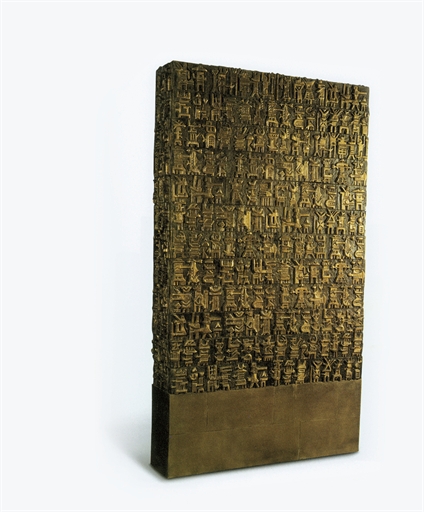Despite their seemingly unending struggle in lending to needy manufactures and businesses, Iranian banks are rather strangely cultivating some unheard love for art. Although banks’ artistic ventures are being touted as part of their “social responsibilities” however benevolent their intentions may or may not be, they are expected to invest in profitable areas. So the question that arises is how artistic is banks’ approach to art?
Banks’ fondness for artworks has a colorful presence around the world; eminent lenders such as Deutsche Bank, UBS and Bank of Scotland are currently among the most avid art investors/collectors.
The craze for art sales, ironically, reached its pinnacle during the global economic meltdown of 2008-2009 which earned for the art market the title of a ‘crisis free’ enterprise.
Exactly at that point , Bank Pasargad of Iran made its foray into the market and managed to sell “Oh, Persepolis”, a bronze sculptured wall by Parviz Tanavoli, at a record price of $2.8 million at Christie’s auction in Dubai.
Pasargad entered the domestic art market two years ago when it sold one of Sohrab Sepehri’s (a celebrated contemporary poet and artist, 1928-80) painting at the giddy price of 18 billion rials ($610,000).
Bank Pasargad became a pioneer bank in fine arts business promotion when it established a contemporary art museum in 2008, showcasing 140 pieces of contemporary artifacts.
The bank’s spurge on art works, especially those created by young artists, has earned the praise of both Ali Jannati, the minister of culture and President Hassan Rouhani for its success in promoting the economy of art and setting up the art museum.
However, this cultural mandate also has a lucrative dimension.
The face-value for an artwork is the exact amount a buyer is willing to pay for it which is not determined by “the signature” of its creator. In this way, many amateur works have provided substantial returns for investors. So, a decent and well-organized promotion of an art collection serves to add value to the work and, of course, is ultimately beneficial for the artists too.
Another alternative for banks is to provide art-secured loans, but our banks have yet to embrace this provision.
New Funds Emerge
It was announced this week that Ayandeh Bank, another private bank, will provide banking and e-banking services to members of the Honar (art) Credit Fund and help the fund develop Artists’ ID card. Earlier this month, Bank Sarmaye and Honar Fund had signed an agreement to provide special banking services and loans for artists.
Honar Credit Fund, established in 2003, is a non-government entity run by a board of senior bankers as well as the minister of culture and Islamic guidance. The fund as the economic wing of the ministry of culture promotes the economy of art in collaboration with banks.
With top bankers sitting on the board of directors, the fund not only can help serve the art community’s economic well-being, it can be the bankers’ third eye for art investment. Banks need a pillar also to appraise artworks and advice investors. This is among the primary duties of art funds across the world.
The Export Development Bank of Iran is another lender whose support for art is worthy of mention. The major business lender has already expressed interest in promoting the export of “cultural products.”
Statistics provided by the Tehran Chamber of Commerce -- which has recently formed a special commission for art and culture -- shows that during the first half of the Iranian fiscal year (started March 21), Iran earned 16.7 billion rials ($579,000) from selling art pieces up from the previous year’s 3.3 billion rials ($125,000). The record total revenue from art exports was in 2009 when it raked in $2.2 million.
It seems the art community is now resolved to enhance its economic status and its cooperation with banks is a step forward. However, attracting foreign investment, developing online markets and encouraging art investment among ordinary investors would be crucial for the infant art market to flourish in the long-run.



